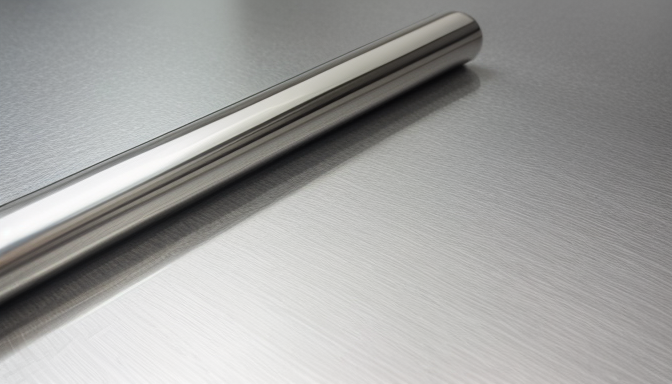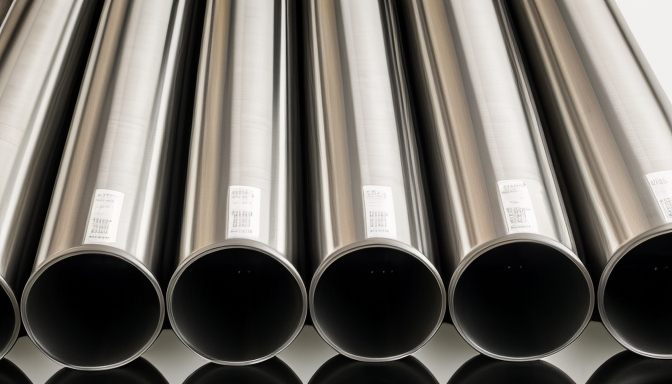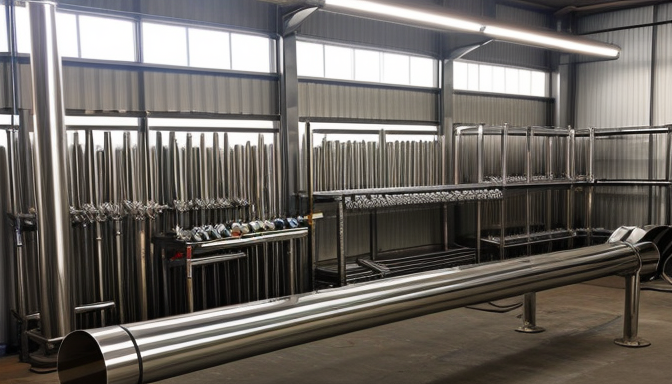304 stainless steel pipes are a popular choice in various industries due to their excellent properties and versatility. They are made from a stainless steel alloy that contains chromium and nickel, which not only enhances their strength but also provides remarkable corrosion resistance. This means they can withstand harsh environments, making them ideal for both indoor and outdoor applications.
When we think about 304 stainless steel pipes, we often picture their use in plumbing, construction, and even food processing. But did you know that they are also used in chemical industries and oil refineries? Their ability to resist oxidation and maintain integrity under high temperatures makes them a go-to option for many engineers and designers.
One of the most appealing aspects of 304 stainless steel pipes is their ability to be easily welded and fabricated. This flexibility allows for customization according to specific project needs. Imagine needing a pipe that fits perfectly into your design—304 stainless steel can be shaped and sized to meet those requirements without compromising strength.
In addition to their structural benefits, the aesthetic appeal of these pipes cannot be overlooked. Their shiny, smooth surface not only looks great but also minimizes the buildup of dirt and grime, making maintenance a breeze. So, if you’re considering a project that requires durability and style, 304 stainless steel pipes should be high on your list.
Now, let’s talk about the price and weight of these pipes. Understanding these factors is essential for budgeting and planning. Prices can fluctuate based on market demand and specific supplier offerings. Additionally, the weight of the pipes can vary significantly based on their size and wall thickness, which is crucial for transportation and installation. Here’s a quick overview of how weight can differ:
| Pipe Diameter (inches) | Wall Thickness (inches) | Weight (lbs/ft) |
|---|---|---|
| 1 | 0.065 | 0.68 |
| 2 | 0.065 | 1.24 |
| 3 | 0.065 | 1.83 |
As you can see, the weight varies with the diameter and wall thickness. This information is crucial when planning your project logistics. You don’t want to be caught off guard when it comes time to lift and install these pipes!
In summary, 304 stainless steel pipes are a reliable choice for many applications due to their strength, corrosion resistance, and aesthetic appeal. Understanding their pricing, weight, and properties will help you make informed decisions for your projects. Whether you’re in construction, plumbing, or any other field, these pipes can be a valuable asset.
304 Stainless Steel Pipe Price
Understanding the pricing factors of 304 stainless steel pipes is crucial for budgeting. Prices can vary widely based on several factors. For instance, the market demand plays a significant role. When demand is high, prices tend to increase. Conversely, when the market is saturated, costs can drop.
Another factor influencing price is the supplier. Different suppliers may offer varying prices based on their sourcing, quality, and service. It’s always a good idea to shop around. Comparing quotes from multiple suppliers can save you money. You might find a better deal just by asking a few more questions.
Specifications of the pipes also matter. The diameter, wall thickness, and length all contribute to the overall cost. Generally, thicker walls and larger diameters lead to higher prices. Here’s a quick overview:
| Pipe Diameter (inches) | Wall Thickness (inches) | Approximate Price per Foot ($) |
|---|---|---|
| 1 | 0.065 | 3.50 |
| 2 | 0.065 | 5.00 |
| 3 | 0.065 | 7.50 |
As you can see, the price varies depending on the specifications. It’s essential to consider what you need the pipe for. If you’re working on a project that requires specific dimensions, it’s worth investing in the right size. You don’t want to compromise on quality just to save a few bucks.
Additionally, keep in mind that prices can fluctuate based on global steel market trends. Events in the economy, changes in tariffs, and even natural disasters can affect the cost of materials. Staying informed about these factors can help you make better purchasing decisions.
In conclusion, while the price of 304 stainless steel pipes can vary, understanding the influencing factors can help you budget effectively. Always consider your project’s requirements and compare prices from different suppliers. This way, you can ensure you’re getting the best value for your investment.

304 Stainless Steel Pipe Weight
The weight of 304 stainless steel pipes is a crucial element to consider, especially when it comes to transportation and installation. Why is this important? Well, the heavier the pipe, the more effort it takes to handle and install. It also impacts shipping costs. So, knowing the weight can save you both time and money.
Now, the weight of these pipes can vary significantly based on a few factors. First, the dimensions of the pipe play a major role. For instance, a larger diameter pipe will obviously weigh more than a smaller one. Second, the wall thickness also matters. Thicker walls mean more material, which translates to a heavier pipe. It’s a bit like comparing a soda can to a soup can; one is lighter because it has less material.
To give you a clearer picture, let’s take a look at a simple table that outlines the weight of various sizes of 304 stainless steel pipes:
| Pipe Diameter (inches) | Wall Thickness (inches) | Weight (lbs per foot) |
|---|---|---|
| 1 | 0.065 | 0.48 |
| 2 | 0.065 | 1.20 |
| 3 | 0.065 | 1.89 |
| 4 | 0.065 | 2.67 |
As you can see from the table, the weight increases as the diameter and wall thickness increase. This is essential information for anyone working on a project that involves these pipes. You wouldn’t want to plan a project only to find out later that the pipes are too heavy to manage!
In my own experience, I once worked on a plumbing project where we underestimated the weight of the pipes. We ordered a bunch of 4-inch pipes, thinking they would be easy to handle. But once they arrived, we quickly realized that moving them around was a workout! Lesson learned: always check the weight before making any decisions.
In conclusion, understanding the weight of 304 stainless steel pipes is vital for planning and executing your projects efficiently. Keep in mind the dimensions and wall thickness when making your choices. This knowledge not only helps in budgeting but also ensures smooth operations on-site.
304 Stainless Steel Pipe Properties
When it comes to 304 stainless steel pipes, their properties are what truly set them apart. This type of stainless steel is known for its remarkable corrosion resistance. Imagine living in a place with high humidity or frequent rain. Typical metals might rust and degrade, but 304 stainless steel stands strong. It’s like having an umbrella that never fails you, no matter how intense the storm.
Another noteworthy property is its high strength. This means it can withstand significant pressure and stress. Think of it as the sturdy backbone of your plumbing or structural system. Whether it’s water, gas, or even chemicals flowing through, you can trust that 304 stainless steel pipes will hold up under pressure.
Furthermore, 304 stainless steel is quite versatile. It can be easily shaped and welded, making it a favorite among manufacturers. This flexibility allows for a variety of designs and applications. From kitchen appliances to industrial machinery, these pipes fit right in. They adapt like a chameleon, seamlessly blending into different environments.
In addition to strength and adaptability, 304 stainless steel pipes are also easy to clean. Their smooth surface prevents dirt and grime from sticking, which is a huge plus in industries like food processing. Picture a restaurant kitchen where cleanliness is key. With 304 stainless steel, maintenance becomes a breeze.
To give you a clearer picture of why 304 stainless steel pipes are so popular, here’s a quick comparison of their properties:
| Property | Description |
|---|---|
| Corrosion Resistance | Excellent resistance to rust and oxidation. |
| Strength | High tensile strength, suitable for high-pressure applications. |
| Weldability | Easy to weld and fabricate. |
| Cleanability | Smooth surface for easy maintenance and hygiene. |
In conclusion, the properties of 304 stainless steel pipes make them an essential choice for various applications. Whether you’re in construction, manufacturing, or food service, these pipes offer reliability and durability. Choosing the right material can make all the difference in the long run. So, next time you’re considering materials for your project, remember the advantages of 304 stainless steel. It’s not just a pipe; it’s a smart investment.

304 Stainless Steel Pipe Sizes
When it comes to 304 stainless steel pipes, size matters. Choosing the right size is crucial for ensuring that your project runs smoothly. But how do you know what size you need? It’s not just about picking a number; it’s about understanding the application. Different industries have different requirements. For instance, a plumbing system might need smaller pipes, while industrial applications could require larger diameters.
304 stainless steel pipes are available in a variety of sizes. These sizes are generally categorized by their diameter and wall thickness. The diameter can range from a small 1/8 inch to as large as 36 inches or more. The wall thickness also varies, which can significantly impact the pipe’s strength and weight. A thicker wall means more durability, but it also adds weight. Here’s a quick overview of some common sizes:
| Nominal Pipe Size (NPS) | Outside Diameter (OD) (inches) | Wall Thickness (inches) | Weight (lbs/ft) |
|---|---|---|---|
| 1/2 | 0.840 | 0.109 | 1.24 |
| 1 | 1.315 | 0.133 | 1.68 |
| 2 | 2.375 | 0.154 | 2.27 |
| 3 | 3.500 | 0.216 | 3.65 |
| 4 | 4.500 | 0.237 | 4.79 |
These sizes are just a glimpse into the world of 304 stainless steel pipes. Depending on your project, you might need to consider other factors like length and fittings as well. For example, if you’re working on a construction project, you might need longer pipes to span greater distances. In contrast, smaller projects might require shorter lengths.
Also, keep in mind that the size you choose can affect the flow rate of liquids or gases. A larger diameter allows for a greater volume to pass through, which can be essential in certain applications. What’s more, the right size can improve efficiency and reduce costs in the long run. In short, understanding the sizes of 304 stainless steel pipes can mean the difference between a successful project and a costly mistake.
In conclusion, when you’re selecting your 304 stainless steel pipe, don’t just grab the first one you see. Think about the size, the application, and how it fits into your overall project. It’s like finding the right key for a lock; the right fit makes all the difference.
Frequently Asked Questions
- What is 304 stainless steel pipe used for?
304 stainless steel pipes are incredibly versatile and are commonly used in a variety of industries. They’re ideal for applications that require high corrosion resistance, such as in food processing, chemical manufacturing, and even in plumbing systems. Think of them as the Swiss Army knife of piping solutions!
- How do I determine the price of 304 stainless steel pipes?
The price of 304 stainless steel pipes can fluctuate based on several factors. These include market demand, the supplier you choose, and the specific dimensions or wall thickness of the pipe you need. It’s a bit like shopping for a car—features and brand reputation can significantly influence the cost!
- What are the typical weights of 304 stainless steel pipes?
The weight of these pipes varies based on their size and wall thickness. Generally, heavier pipes can be more challenging to transport and install, so it’s essential to consider these factors when planning your project. It’s like packing for a trip; you want to make sure you’ve got everything you need without overloading your suitcase!
- Are there different sizes available for 304 stainless steel pipes?
Absolutely! 304 stainless steel pipes come in a range of sizes to cater to different project needs. Understanding the standard sizes can help you make the right choice for your application, ensuring you get the perfect fit—like finding the right pair of shoes!
- What properties make 304 stainless steel pipes special?
These pipes boast unique properties, such as excellent corrosion resistance and high tensile strength. This means they can withstand harsh environments without deteriorating, making them a reliable choice for many applications. Think of them as the superheroes of the piping world, ready to tackle any challenge!
